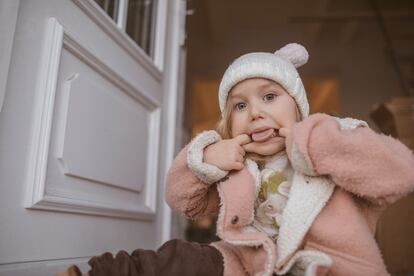Disobedient kids who talk back: What can parents do?
Teaching children to identify and manage their emotions and giving them adequate, age-appropriate explanation is key for them to accept their mistakes and learn to tolerate frustration

One of the things that can most upset parents is when their child talks back, challenges them, or refuses to do something. These are the words of Anna Morató, author of a series of children’s books called De mayor quiero ser… ¿Qué hago con mis emociones? (in English, When I’m older I’d like to be… What do I do with my emotions?). The writer says that, when this happens, parents may react by getting mad, shouting or dishing out punishment: “This method will only make the situation worse, which is to say, what they’re doing is exploding emotionally, just like the kids.” Morató speaks of the importance of processing emotions and what they mean: “Emotions and feelings are alarms with which our body lets us know that something is bothering us and it’s important to learn to listen to them, feel them, and learn how to control them.”
The author also encourages us as adults to be there for children and not to add to the “emotional chaos.” “To help them correctly, we need to calmly validate their emotion and let them learn they can dial down that emotion, and not through external stimulus like yelling at them, punishing them or rewarding them for ceasing to express it,” she writes. The author explains that in this way, children receive the message that they must make an effort to regulate their emotions without causing damage or speaking cruelly to those around them, or to themselves, and that if they do, they must accept that they’ve made a mistake. As Morató points out, this process requires a great deal of patience on the part of adults involved, because it is linked the maturation of the child’s brain, a process that continues until they are approximately 21 years old.
Morató also specifies that there may be another factor behind this kind of behavior. In the case of anger, she maintains that there may be reasons that go unnoticed by parents: “And it is important to try to get to the root of these emotions and feelings in order to solve them.” In addition, she stresses that it is also necessary for parents to know how to regulate themselves emotionally so that their children can learn to do so. The author says that happy people are those who, when they have uncomfortable emotions, know how to process them and try to have a positive attitude.
Offer explanations
For her part, psychologist Esther Almagro Huertas, who has a master’s degree in general health and who works at Aspas Córdoba — an association of parents and friends of deaf people in the city of Córdoba — adds that it’s fundamental that adults focus on working with their own emotions and frustrations to be able to act in an appropriate and conscious way with their kids. When it comes to establishing limits, she counsels doing so calmly, consistently, and with dialogue, keeping in mind one’s own inner workings and self-learning. As the expert explains, children may sometimes not understand the reasons why what they’ve done isn’t considered a good thing. She argues that, as parents, we can’t correct their behavior from our adult perspective without explaining the reasons why certain things are necessary, and taking into account children’s age and level of understanding: “We are the adults, so must provide them with clear explanations so that they learn to integrate them in the best way possible.”
For Javier Royo Moya, a child and adolescent psychiatrist at the Navarra Health Service, recent changes regarding the education of children have been drastic. “In the 1960s, parental education focused on a model of excessive limits and an exaggerated use of authoritarianism (which is not the same as authority). There was no need to explain to children the reasons behind setting limits and any hint of dissent was settled with ‘Because I said so,’” he reflects. As Royo Moya explains, this model was more focused on fear than healthy learning of reasonable limits.
For the doctor, the extremes to which the educational model has arrived today can be surprising. “Some parents talk and negotiate with their three- to five-year-old kids as if they were adolescents, without being conscious of the fact that at those ages, most children don’t want to listen or they’re simply not capable of understanding without an additional factor,” he says. He also argues that a consequence-free model that is too relaxed does not allow children to learn to tolerate frustration: “If that’s not taken into account, taking away your eight-year-old child’s cell phone can become almost impossible.” For Royo Moya, in general terms, the younger the child, the more targeted communication needs to be regarding the behavior you wish to achieve: “With an adolescent, however, communication and negotiation must take precedence, while making it clear that there are limits, like respect, that are non-negotiable.”
As the doctor points out, a model based on the child learning that making mistakes is part of the learning process is preferable: “If, for example, there is an agreement that they will come home at a certain hour and systematically, they’re not doing that, the child and their parents should assume that they’re not yet sufficiently responsible. In that case, they will have to accept a consequence that is proportionate to the risk of that behavior.”
Sign up for our weekly newsletter to get more English-language news coverage from EL PAÍS USA Edition
Tu suscripción se está usando en otro dispositivo
¿Quieres añadir otro usuario a tu suscripción?
Si continúas leyendo en este dispositivo, no se podrá leer en el otro.
FlechaTu suscripción se está usando en otro dispositivo y solo puedes acceder a EL PAÍS desde un dispositivo a la vez.
Si quieres compartir tu cuenta, cambia tu suscripción a la modalidad Premium, así podrás añadir otro usuario. Cada uno accederá con su propia cuenta de email, lo que os permitirá personalizar vuestra experiencia en EL PAÍS.
¿Tienes una suscripción de empresa? Accede aquí para contratar más cuentas.
En el caso de no saber quién está usando tu cuenta, te recomendamos cambiar tu contraseña aquí.
Si decides continuar compartiendo tu cuenta, este mensaje se mostrará en tu dispositivo y en el de la otra persona que está usando tu cuenta de forma indefinida, afectando a tu experiencia de lectura. Puedes consultar aquí los términos y condiciones de la suscripción digital.
More information
Últimas noticias
Most viewed
- Sinaloa Cartel war is taking its toll on Los Chapitos
- Oona Chaplin: ‘I told James Cameron that I was living in a treehouse and starting a permaculture project with a friend’
- Reinhard Genzel, Nobel laureate in physics: ‘One-minute videos will never give you the truth’
- Why the price of coffee has skyrocketed: from Brazilian plantations to specialty coffee houses
- Silver prices are going crazy: This is what’s fueling the rally











































